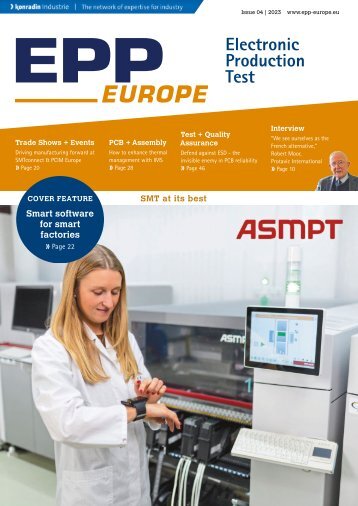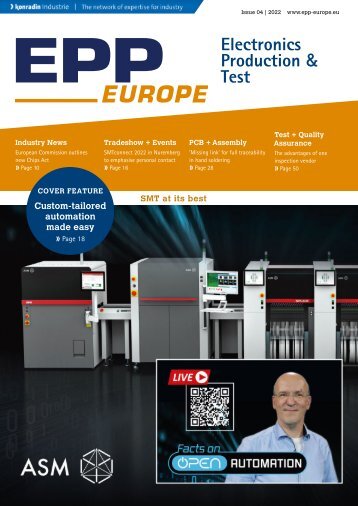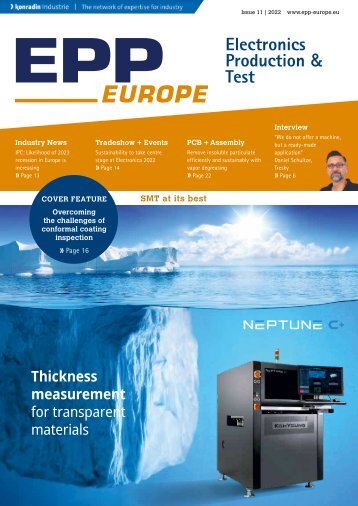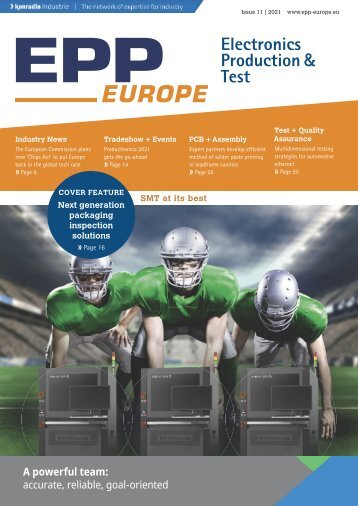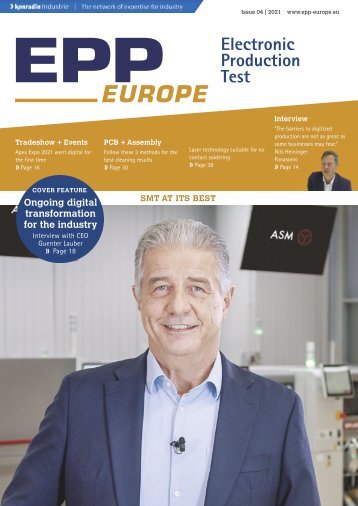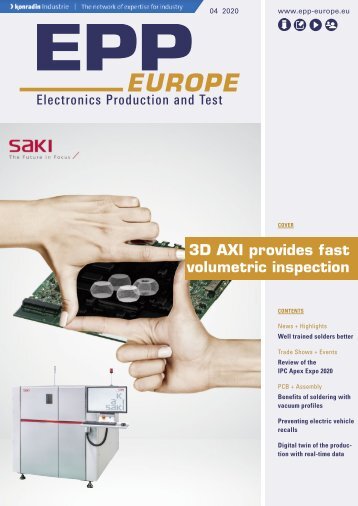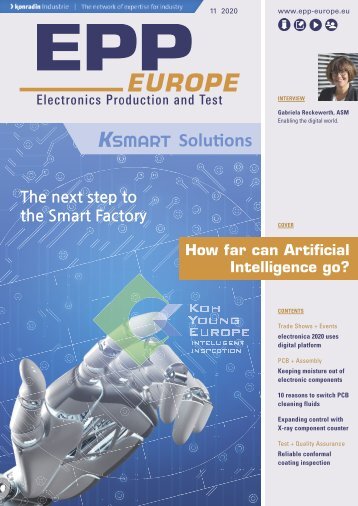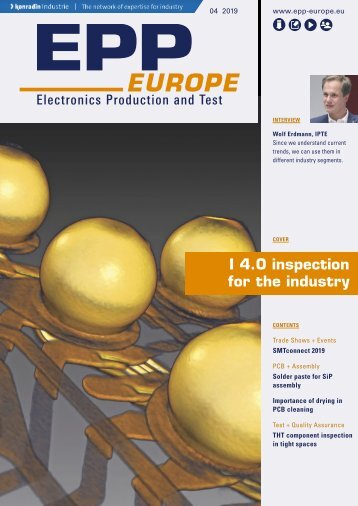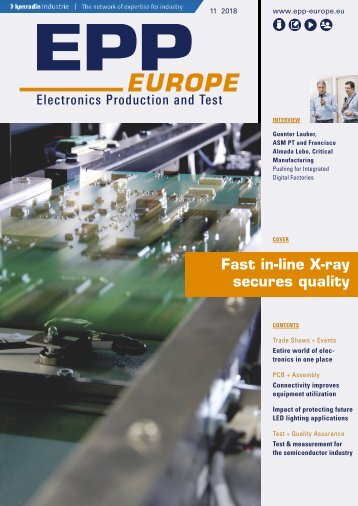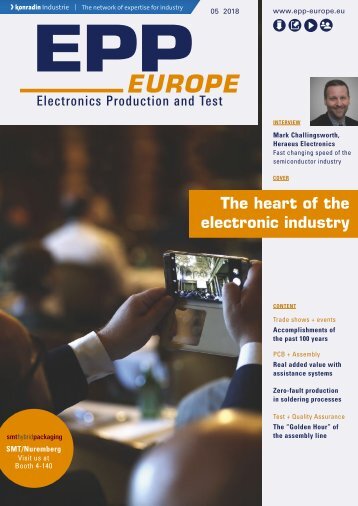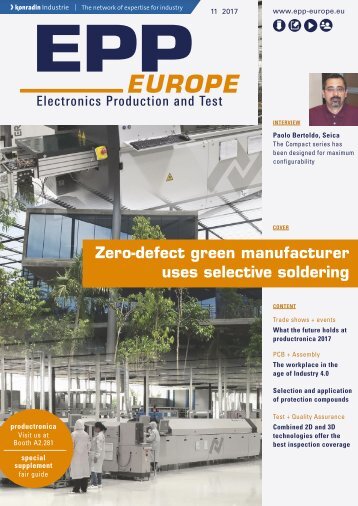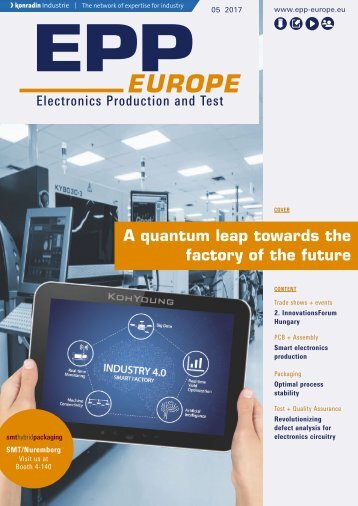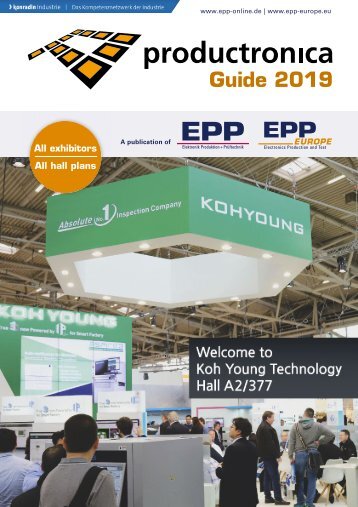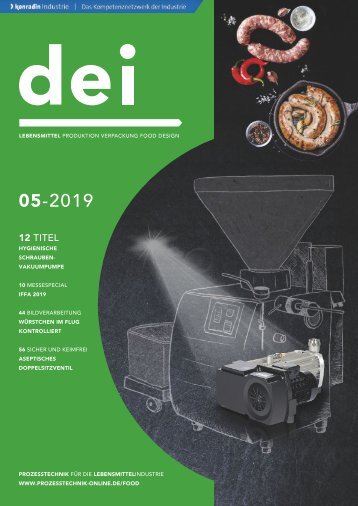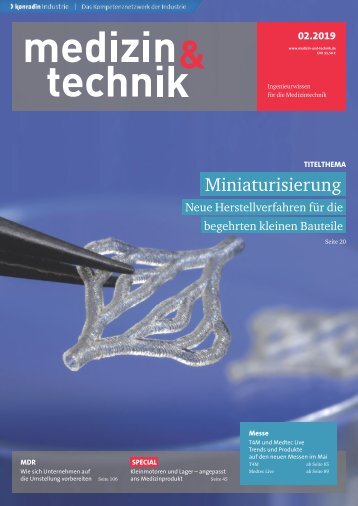EPP Europe P2.2022
- Text
- Measurement
- Assembly
- Semiconductor
- Soldering
- Solutions
- Manufacturing
- Components
- Electronic
- Inspection
- Electronics
» PCB & ASSEMBLY
» PCB & ASSEMBLY Removing insoluble particulate from semiconductors Vapor degreasing explained Vapor degreasing is an efficient and sustainable way of removing contaminants, like insoluble particulate, from semiconductor wafers and components. In so doing, it helps to ensure their later reliability and operability, as Senior Chemist at MicroCare, Elizabeth Norwood, explains. Semiconductor manufacturing typically takes place in cleanrooms to protect the complex chips from contamination. But almost all semiconductor wafers need some cleaning during manufacture to reticulate accumulates on the wafer surface, it can interfere with and degrade deposited films that come later. It can also cause shadowing during lithography, reduce contact exposure resolution or create an uneven surface that could result in cracking during exposure. Particulate is also a common contaminant found on FOUPs (Front Opening Unified Pods) used for wafer transferring. So, the FOUPs should also be cleaned to prevent FOUP-to-wafer contamination. Particulate is not soluble in traditional cleaning fluid, so it must be removed by either chemical or mechanical means. There are various ways to clean semiconductors and FOUPs. One is via vapor degreasing with specialty particulate displacement fluids. Source: Microcare Vapor degreasing combines cleaning, rinsing and drying in one step to optimize throughput time Demand for sophisticated, complex electronics is rising. But the intricate nature of these assemblies, which include delicate semiconductor wafers, can cause a reliability risk if post-etching cleaning is not performed well. Contaminants must be removed without damage or alteration to the wafers. Failure to remove these impurities could cause etching, corrosion or pitting, resulting in poor semiconductor operability and reliability, Cleaning semiconductors move contamination resulting from the manufacturing process. Contaminants come from many sources including chip transport, handling, storage and manufacturing. Soils vary and can include dust, fingerprints, oils and water. One of the most common semiconductor contaminants is particulate. This comprises dust particles, skin flakes, fibers and other process contaminants. Particulate contamination comes from the air, from the abrasion of moving parts, from clothing, or from dirty, unfiltered etching fluids. These particles either electrostatically bond to the substrate or they get trapped in the wafer substrate geometry. Particulate impacts wafer performance in different ways. For example, as par- What is vapor degreasing? Vapor degreasing is a closed-loop system with two components: a vapor degreaser and particle displacement fluid. Most vapor degreasing systems are toploading batch-style cleaning machines with two compartments: the boil sump and the rinse sump. In the boil sump, a batch of parts including FOUPs, MOSFETS Almost all semiconductor wafers require cleaning to remove contamination caused by the manufacturing process Source: Microcare 22 EPP Europe » 11 | 2022
Bild: Microcare Particulate contamination comes from the air, from the abrasion of moving parts, from clothing, or from dirty, unfiltered etching fluids (Metal Oxide Semiconductor Field-Effect Transistors) or other semiconductor components are immersed in the heated fluid for cleaning. Often, agitation helps enhance the cleaning fluid’s effectiveness. This is done by leveraging the boiling action of the cleaning fluid, adding vibrating ultrasonic energy or using a spray wand to loosen the particulate off the substrate. Once cleaned, the parts mechanically transfer to the rinse sump. The parts rinse in pure, uncontaminated fluid or inside the fluid vapors themselves. The components come out cool so they are immediately ready for use or for the next stage of processing. Unlike the commoner aqueous cleaning, vapor degreasing combines cleaning, rinsing and drying in one step to maximize takt time. It takes as little as 6–20 minutes per batch. Moreover, vapor degreasers typically have a smaller footprint than aqueous cleaners. The systems take up less valuable production space and, because vapor degreasing cleaning is a simple, predictable and repeatable process, it is easy to qualify and validate for cleanroom use. Good particle displacement The displacement cleaning fluids used inside vapor degreasers have chemical and physical properties that are advantageous to particle displacement and help accelerate the cleaning process. Small particles can be difficult to remove from wafers since strong electrostatic forces exist between the particles and the wafer substrate. A particle adheres to the substrate through adhesion forces, whether it is an electrostatic charge or Van der Waals force. This adhesion creates a friction force parallel with the surface: static friction if the particle is not moving, dynamic friction if it is. To remove the contaminant, the cleaning fluid must reduce the thickness of the laminar boundary layer, break the bond and allow the particles to release from the substrate. Some displacement fluids are a mixture of hydrofluoro-olefin (HFO) and ethanol that removes fine particulate down to the micron or even sub-micron range. The alcohol component forms hydrogen bonds at the fluid-substrate interface, reducing the intermolecular forces between the particle and the substrate. This allows the particulate to lift more easily from the substrate. Plus, the fluorocarbon-based fluids are synthetically derived, allowing for a higher purity level than traditional hydrocarbon-based cleaning fluids. These ultra-pure fluids dry quickly and completely without leaving spots or residue behind. High density & low viscosity Particulate displacement fluids are dense: typically, 20–40% heavier than water and 50% heavier than alcohol. They also have a lower viscosity than IPA (Isopropyl Alcohol), water or water with surfactant additives. The combination of the higher density and the lower viscosity About the author Elizabeth Norwood is a Senior Chemist at MicroCare, which offers precision cleaning solutions. She has been in the industry more than 25 years and has a BS in Chemistry from the University of St. Joseph. Norwood researches, develops and tests cleaningrelated products. She currently has one patent issued and two pending for her work. For more information, visit www.microcare.com. THE FLEXIBILITY FOR MASS INTERCONNECT ODU-MAC ® GET YOUR SOLUTION NOW! black-line@odu.de Electromechanical version Eight tensioning points for equal connections Flexible configuration with ODU-MAC® modules Including cable assembly www.odu.de EPP Europe » 11 | 2022 23
- Page 1 and 2: Issue 11 | 2022 www.epp-europe.eu E
- Page 3 and 4: » EDITORIAL » EDITORIAL Dear read
- Page 5 and 6: Vapor degreasing: almost all semico
- Page 7 and 8: duce machines in high quantities wi
- Page 9 and 10: NEWS & HIGHLIGHTS « 3. Digital sup
- Page 11 and 12: Boost for U.S. semiconductor indust
- Page 13 and 14: NEWS & HIGHLIGHTS « QUALITY PIEKTR
- Page 15 and 16: TRADE SHOWS & EVENTS « ified the g
- Page 17 and 18: AT A GLANCE In this article, Koh Yo
- Page 19 and 20: The LIFT measurement principle. The
- Page 21: MK Versuchsanlagen PCB maker acquir
- Page 25 and 26: Rework technologies PDR launches in
- Page 27 and 28: Versatile format The biggest differ
- Page 29 and 30: Product Updates « PCB & ASSEMBLY I
- Page 31 and 32: PCB & ASSEMBLY « Source: ED&A Sour
- Page 33 and 34: Adhesives manufacturer strengthens
- Page 35 and 36: Dual-curing adhesive for medical de
- Page 37 and 38: Selective soldering systems Sasinno
- Page 39 and 40: New online offering for 4K digital
- Page 41 and 42: Source: Göpel electronic AXI text
- Page 43 and 44: Zusammenfassung Röntgensysteme mü
- Page 45 and 46: RF performance characterization Tes
- Page 47 and 48: G3VM-21MT reference design board te
- Page 49 and 50: The range of T-circuit MOSFET relay
- Page 51 and 52: MEETINGS & COURSES Jan. 21-26 CONFE
Inappropriate
Loading...
Mail this publication
Loading...
Embed
Loading...


